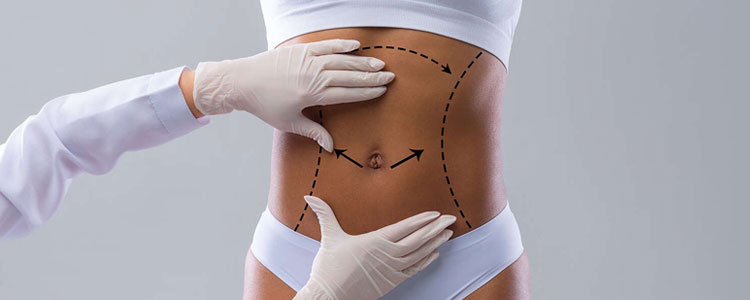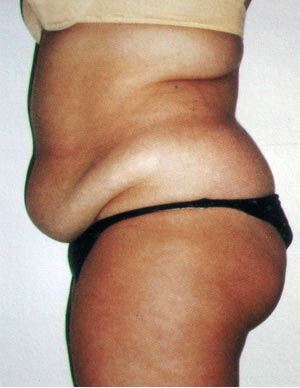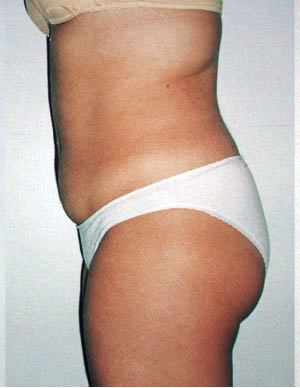ABDOMINAL LIPOSUCTION

The intervention is for re-contouring the body by removing the excess fat and skin of the abdominal area.
After establishing the degree of relaxation, the doctor proceeds to design accurate access incisions which are generally made around the elastic band of your underwear in order to remain hidden below them.
The upright abdominal muscles are saturated together in order to give more tone to the voluminous abdominals.
The intervention is performed under general anesthesia or local.

Before intervention

After intervention
Expectations from an abdominal plastic surgery
Many pregnancies or large weight loss can lead to a pronounced abdomen skin loss. If you have experienced this and are sure that this problem is not solved with diets, activities, or sport massages, it will be with liposuction. You can consider the abdominal surgery in which the skin and the excess fat tissue are removed.
Results
The surgical removal of skin and fat unfortunately entails long scars but also remains the only solution to this type of problem.
After the intervention not only bodily proportions are more balanced, but also the mental and physical well-being are often improved considerably.
Before taking a decision for an abdominal plastic surgery make sure that you have experienced all alternative methods to solve the problem.
Anesthesia and recovery
Only small stretches of the belly can be performed under local anesthesia at the doctors clinic of your plastic surgeon.
Usually, it is proceeded under general anesthesia or in a local clinic and the recovery is estimated in 2 days.
Pre-operation analysis by the anaesthesiologist will be made in the same clinic the day before.
Precautions for the first intervention
To minimize the risks and complications follow closely the instructions of your surgeon both before and after the procedure.
Communicate if you suffer from allergies or other chronic diseases. If you bruise easily or if you bleed excessively from a small injury, perhaps we may require some analysis to exclude difficulties of your blood to clot.
If you suffer from vascular disease, varicose veins embolic thrombosis or precautionary measures there will be taken.
Smokers should quit smoking at least 4 weeks before the intervention because the smoke adversely interferes with the process of healing.
They are aspirin-type painkillers that should not be taken during the two weeks before the intervention because their active ingredient interferes with blood clotting and can cause excessive bleeding.
You must avoid all alcohol and sleeping pills.
Take into consideration to diet for a period before the intervention. Watch your weight more closely and that will form more satisfactory results.
You can protect and prepare the skin of the abdominal area with special creams and massage and stimulate circulation with cold showers.
The deposits of their blood 3-6 weeks before action is too big to contribute to its security.
Intervention process
Before anesthesia, the surgeon measures and marks accurately the skin to remove. The abdomen is disinfected. A special liquid vasoconstrictor reduces bleeding during surgery. During anesthesia fat and excess skin are eliminated.
Often there is also a partial liposuction. Abdominal muscles are tightened. With the final suture the final stretch of the abdomen is obtained.
If you must remove all the skin between the navel and pubic line area there is the repositioning of the belly button strictly on the tensed skin. To avoid the risk of accumulation of blood or interstitial fluid drainage is applied for one or more days. Also during anesthesia a light compressive bandage is placed around the abdominals.
What happens after surgery
Immediately after the intervention will be given painkillers to give relief and relax. To avoid risks of embolism wear elastic stockings or take medications. You will be asked to perform exercises to stimulate muscle movement and oxygen circulation of the tissue.
It’s indicated a slight compression wearing a sheath during the day for 6 weeks. Cold showers stimulate the healing process.
The absorbable thread suture dissolve on their own, and the others will be removed after 3-6 weeks.
After about 10-14 days the swelling will be almost totally regressed and suture disappeared. After a few weeks will be completely healed.
Possible complications
The healing of the wound, which is very long, in rare cases can be slowed by edema, secreted or bacteriological infection. The sensitivity of the skin and the drainage of lymphatic fluid regenerate only gradually over a period of several months, and may remain low in the region of the scar.
A significant loss of blood is countered with infusions or in extreme cases with blood transfusion. Thrombosis and embolism are rare but can create significant problems on movement and breathing. Very evident scars can be corrected with a little retouching surgery.
Precautions after surgery
Move with caution for 6-8 weeks after the end of the intervention in order to avoid tension in the suture. Typically, you can return to work after about 3 weeks and slowly resume your sport after another two weeks.
